
Concept explainers
(a)
Interpretation:
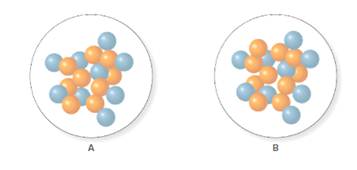
Concept Introduction:
Atomic number of an atom is equal to the number of protons in it. Atomic number is represented by Z.
Answer to Problem 19P
The atomic number for isotope of fluorine A and B is 9.
Explanation of Solution
In the molecular model of fluorine, orange balls represent neutrons, whereas blue balls represent protons. Since the number of protons from given molecular models A and B is 9, the atomic number becomes 9 for A and B both, as the atomic number is equal to the number of protons in that atom.
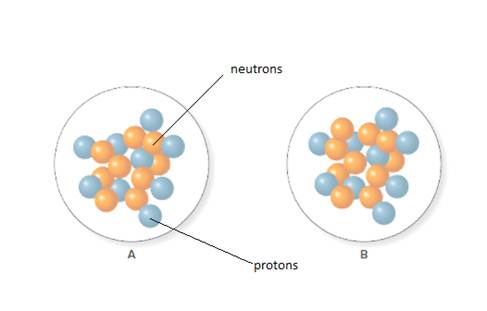
(b)
Interpretation:
Mass number for each isotope of fluorine given below should be predicted.
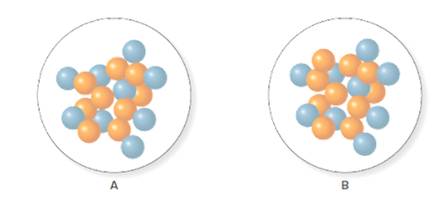
Concept Introduction:
The mass number is equal to the number of protons and neutrons in an atom.
Answer to Problem 19P
The atomic number for isotope of fluorine A and B is 18 and 19 respectively.
Explanation of Solution
From the molecular model of an isotope of fluorine, the number of neutrons can be counted. Thus, the number of neutrons in A and B is 9 and 10 respectively.
As
For A and B, the mass number will be calculated as follows:
(c)
Interpretation:
Number of protons for each isotope of fluorine given below should be predicted.
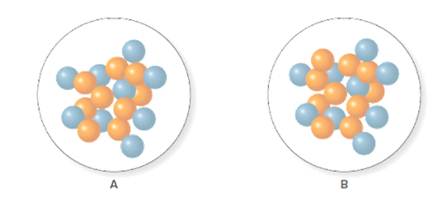
Concept Introduction:
The number of protons is equal to the atomic number of that atom.
Answer to Problem 19P
The number of protons in isotope of fluorine A and B is 9.
Explanation of Solution
In the molecular model of fluorine, protons are represented by blue balls. Thus, the number of protons in A and B will be calculated by counting the number of blue balls in A and B in the given figure as follows:
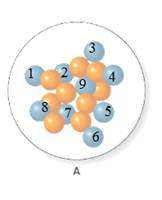
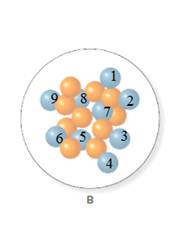
Thus, the number of protons in A and B is 9.
(d)
Interpretation:
The number of neutrons for each isotope of fluorine given below should be predicted.
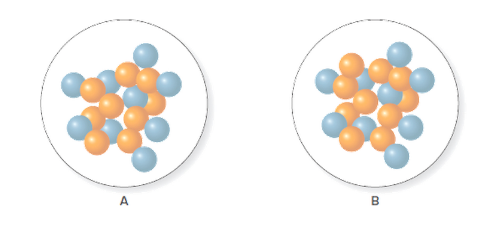
Concept Introduction:
The mass number is the sum of all the protons and neutrons present in an atom. Thus, the number of neutrons can be calculated simply by subtracting the number of protons from the mass number of that atom.
Answer to Problem 19P
The number of neutrons in A and B is 9 and 10 respectively.
Explanation of Solution
For A, the mass number and number of protons are 18 and 9 respectively. Thus, the number of neutrons in A will be calculated as follows:
For B the mass number and number of protons are 19 and 9 respectively. Thus, the number of neutrons in B will be calculated as follows:
(e)
Interpretation:
The isotope symbol for each isotope of fluorine given below should be predicted.
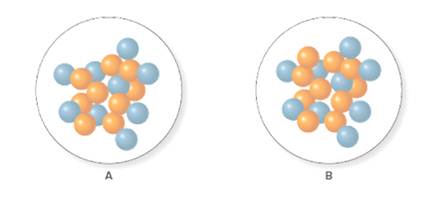
Concept Introduction:
Isotopes are the compounds having the same atomic number but different
To write an isotope symbol atomic number (Z) is written on the lower left side and atomic mass(A) is written on the upper left side of an element.
Answer to Problem 19P
The isotope symbol for A and B is
Explanation of Solution
For A, the mass number and atomic numbers are 18 and 9 respectively. Thus, the isotope symbol for A will be represented as follows:
For B, the mass number and atomic numbers are 19 and 9 respectively. Thus, the isotope symbol for B will be represented as follows:
Want to see more full solutions like this?
Chapter 10 Solutions
GENERAL,ORGANIC, & BIOLOGICAL CHEM-ACCES
- Identify and provide a concise explanation of a specific analytical instrument capable of detecting and quantifying trace compounds in food samples. Emphasise the instrumental capabilities relevant to trace compound analysis in the nominated food. Include the specific application name (eg: identification and quantification of mercury in salmon), outline a brief description of sample preparation procedures, and provide a summary of the obtained results from the analytical process.arrow_forwardIdentify and provide an explanation of what 'Seperation Science' is. Also describe its importance with the respect to the chemical analysis of food. Provide specific examples.arrow_forward5. Propose a Synthesis for the molecule below. You may use any starting materials containing 6 carbons or less (reagents that aren't incorporated into the final molecule such as PhзP do not count towards this total, and the starting material can have whatever non-carbon functional groups you want), and any of the reactions you have learned so far in organic chemistry I, II, and III. Your final answer should show each step separately, with intermediates and conditions clearly drawn. H3C CH3arrow_forward
- State the name and condensed formula of isooxazole obtained by reacting acetylacetone and hydroxylamine.arrow_forwardState the name and condensed formula of the isothiazole obtained by reacting acetylacetone and thiosemicarbazide.arrow_forwardProvide the semi-developed formula of isooxazole obtained by reacting acetylacetone and hydroxylamine.arrow_forward
- Given a 1,3-dicarbonyl compound (R1-CO-CH2-CO-R2), indicate the formula of the compound obtaineda) if I add hydroxylamine (NH2OH) to give an isooxazole.b) if I add thiosemicarbazide (NH2-CO-NH-NH2) to give an isothiazole.arrow_forwardAn orange laser has a wavelength of 610 nm. What is the energy of this light?arrow_forwardThe molar absorptivity of a protein in water at 280 nm can be estimated within ~5-10% from its content of the amino acids tyrosine and tryptophan and from the number of disulfide linkages (R-S-S-R) between cysteine residues: Ε280 nm (M-1 cm-1) ≈ 5500 nTrp + 1490 nTyr + 125 nS-S where nTrp is the number of tryptophans, nTyr is the number of tyrosines, and nS-S is the number of disulfide linkages. The protein human serum transferrin has 678 amino acids including 8 tryptophans, 26 tyrosines, and 19 disulfide linkages. The molecular mass of the most dominant for is 79550. Predict the molar absorptivity of transferrin. Predict the absorbance of a solution that’s 1.000 g/L transferrin in a 1.000-cm-pathlength cuvet. Estimate the g/L of a transferrin solution with an absorbance of 1.50 at 280 nm.arrow_forward
- In GC, what order will the following molecules elute from the column? CH3OCH3, CH3CH2OH, C3H8, C4H10arrow_forwardBeer’s Law is A = εbc, where A is absorbance, ε is the molar absorptivity (which is specific to the compound and wavelength in the measurement), and c is concentration. The absorbance of a 2.31 × 10-5 M solution of a compound is 0.822 at a wavelength of 266 nm in a 1.00-cm cell. Calculate the molar absorptivity at 266 nm.arrow_forwardHow to calculate % of unknown solution using line of best fit y=0.1227x + 0.0292 (y=2.244)arrow_forward
 Introductory Chemistry: A FoundationChemistryISBN:9781337399425Author:Steven S. Zumdahl, Donald J. DeCostePublisher:Cengage Learning
Introductory Chemistry: A FoundationChemistryISBN:9781337399425Author:Steven S. Zumdahl, Donald J. DeCostePublisher:Cengage Learning Living By Chemistry: First Edition TextbookChemistryISBN:9781559539418Author:Angelica StacyPublisher:MAC HIGHERChemistry: Matter and ChangeChemistryISBN:9780078746376Author:Dinah Zike, Laurel Dingrando, Nicholas Hainen, Cheryl WistromPublisher:Glencoe/McGraw-Hill School Pub Co
Living By Chemistry: First Edition TextbookChemistryISBN:9781559539418Author:Angelica StacyPublisher:MAC HIGHERChemistry: Matter and ChangeChemistryISBN:9780078746376Author:Dinah Zike, Laurel Dingrando, Nicholas Hainen, Cheryl WistromPublisher:Glencoe/McGraw-Hill School Pub Co General, Organic, and Biological ChemistryChemistryISBN:9781285853918Author:H. Stephen StokerPublisher:Cengage Learning
General, Organic, and Biological ChemistryChemistryISBN:9781285853918Author:H. Stephen StokerPublisher:Cengage Learning Introductory Chemistry: A FoundationChemistryISBN:9781285199030Author:Steven S. Zumdahl, Donald J. DeCostePublisher:Cengage Learning
Introductory Chemistry: A FoundationChemistryISBN:9781285199030Author:Steven S. Zumdahl, Donald J. DeCostePublisher:Cengage Learning Introductory Chemistry: An Active Learning Approa...ChemistryISBN:9781305079250Author:Mark S. Cracolice, Ed PetersPublisher:Cengage Learning
Introductory Chemistry: An Active Learning Approa...ChemistryISBN:9781305079250Author:Mark S. Cracolice, Ed PetersPublisher:Cengage Learning





